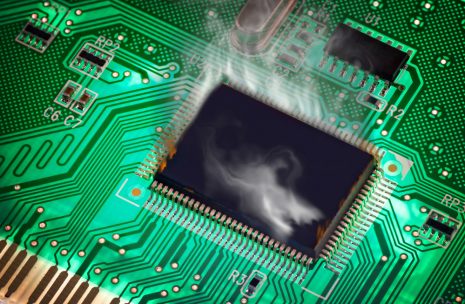Heat is the enemy of high-speed signals. What’s your data center’s plan to beat it?
Faster data rates are an attractive prospect because you can meet changing market demands more quickly.

But getting faster data means you also must deal with more expensive printed circuit boards (PCBs), greater heat and less tolerance for noise in the channel.
As demand for faster data rates grows, data center technology is evolving quickly, and thermal management technology must keep up.
As with most technology improvements, you negotiate some give-and-take with stakeholders. If your goal is faster data rates, then figuring out a single solution that beats the heat while offering superior signal integrity without increasing costs or energy consumption is key.
Today, we’re looking at 200, 400 and even 800 gigabit-per-second transmission rates across QSFP and QSFP-DD I/Os, and the PCBs are struggling. I liken PCBs to a leaky hose – as you send water (or data) through that hose, some of the signal bleeds out. We need something better than a hose so that data integrity is maintained and every ounce of water (or “bit” of data) makes it to the other end.
Also, the industry is moving to modules that consume more power– we’re edging toward 15 watts, and 20 watts is on the horizon. The result is phenomenal amounts of heat that you need to cost-effectively dissipate (think passive solutions).
Thermal management is no longer a nice-to-have; advancements in the electronics industry are upscaling the heat dissipation requirements, creating a demand for continuous innovation in cooling solutions.
Burying a heat sink in the module increases the size and jeopardizes port density. Putting an external heat sink outside the cage is a solution, but it consumes space outside the front faceplate.
Now there’s a simple and elegant solution that resulted from designers taking a fresh look at the orientation of the product.

I said simple, not easy
With the BiPass I/O High-Speed Solution, the high-speed signals no longer go through the PCB. And because of that, we can turn the cage vertical and enable a second heat sink, using more surface area to pull enough heat to cool 20-watt modules.
This advance gives you highly efficient, reliable and resilient thermal management strategies to support your higher density needs in both Copper and optical connectivity.
Better performance
The BiPass I/O high-speed solutions serve as a PCB alternative to enable efficient and reliable implementation as we move toward 56 and 112 Gbps PAM-4 protocols.
Essentially, the BiPass (Flyover) solution improves signal integrity and obtains better thermal cooling without sacrificing port density or a need to resort to expensive thermal management solutions.
Why this works
As its name implies, the BiPass solution allows designers to bypass the lossy printed circuit board by utilizing Temp-Flex high-speed twinax. Because of this, they can achieve lower insertion loss when going from an ASIC in a switch or a router to another server within a rack. From a future perspective, this signal integrity performance and low insertion-loss capability allows designers to use passive Copper throughout the entire design.
The most elegant solutions are not easy, but they are simple. Developing this solution was a two-stage process. Most traditional methods with high-speed signals through the PCB are tied to a horizontal orientation because they have to connect down to the main PCB. That means limited choices for designers.
Freeing high-speed signals from the board created freedom in design and more choices for port density and heat dissipation – and ultimately for companies like yours to realize the benefit of higher wattage modules.
Ready to learn more about thermal management and controlling the temperature of your system using advanced materials and cutting-edge technologies? Let’s talk.